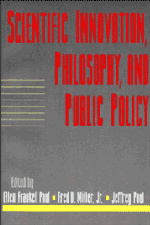Book contents
- Frontmatter
- Contents
- Introduction
- Acknowledgments
- Contributors
- The Human Genome Project: Research Tactics and Economic Strategies
- Choosing Who Will Be Disabled: Genetic Intervention and the Morality of Inclusion
- Germ-Line Genetic Engineering and Moral Diversity: Moral Controversies in a Post-Christian World
- Self-Critical Federal Science? The Ethics Experiment within the U.S. Human Genome Project
- When Politics Drives Science: Lysenko, Gore, and U.S. Biotechnology Policy
- Biotechnology and the Utilitarian Argument for Patents
- Property Rights Theory and the Commons: The Case of Scientific Research
- Property Rights and Technological Innovation
- Medicine, Animal Experimentation, and the Moral Problem of Unfortunate Humans
- A World of Strong Privacy: Promises and Perils of Encryption
- Computer Reliability and Public Policy: Limits of Knowledge of Computer-Based Systems
- Responsibility and Decision Making in the Era of Neural Networks
- Preposterism and Its Consequences
- Index
Biotechnology and the Utilitarian Argument for Patents
Published online by Cambridge University Press: 04 August 2010
- Frontmatter
- Contents
- Introduction
- Acknowledgments
- Contributors
- The Human Genome Project: Research Tactics and Economic Strategies
- Choosing Who Will Be Disabled: Genetic Intervention and the Morality of Inclusion
- Germ-Line Genetic Engineering and Moral Diversity: Moral Controversies in a Post-Christian World
- Self-Critical Federal Science? The Ethics Experiment within the U.S. Human Genome Project
- When Politics Drives Science: Lysenko, Gore, and U.S. Biotechnology Policy
- Biotechnology and the Utilitarian Argument for Patents
- Property Rights Theory and the Commons: The Case of Scientific Research
- Property Rights and Technological Innovation
- Medicine, Animal Experimentation, and the Moral Problem of Unfortunate Humans
- A World of Strong Privacy: Promises and Perils of Encryption
- Computer Reliability and Public Policy: Limits of Knowledge of Computer-Based Systems
- Responsibility and Decision Making in the Era of Neural Networks
- Preposterism and Its Consequences
- Index
Summary
INTRODUCTION
Biotechnology surpasses even computer technology in predictions of its potential for revolutionary effects on humankind. It includes agribusiness (genetically engineered plants, animals, hormones, etc.) and pharmaceuticals (diagnostics, genetic therapies, etc.). The U.S. government began investing heavily in biotechnology research in the 1980s, and by 1987 had spent approximately $2.7 billion to support research and development (R and D), including $150 million for agricultural biotechnology. The approximately sixty U.S. biotechnology companies invested $3.2 billion in R and D in 1991 alone, with a total of more than $10 billion spent since the industry began in the late 1970s.
Patenting the products and processes of biotechnology is a major legal, economic, and moral controversy. Patents grant the exclusive right to make, use, or sell an invention for a period of seventeen years. For an invention to be patentable, it must be novel, useful, and nonobvious to the average person skilled in the discipline. Ideas, theories, mathematical algorithms, laws of nature, and the like cannot be patented; processes (including production methods, special techniques, and diagnostic methods), products (such as microorganisms, enzymes, plasmids, cell lines, and DNA and RNA sequences), and new uses of an existing product can be patented.
Patents are already very common in biotechnology; for example, one source reports that Genentech, the company which developed the process to produce human insulin, has about fourteen hundred patent applications outstanding. Many industry spokespersons have claimed that patents are essential for the growth of biotechnology.
- Type
- Chapter
- Information
- Scientific Innovation, Philosophy, and Public Policy , pp. 113 - 144Publisher: Cambridge University PressPrint publication year: 1996
- 1
- Cited by



